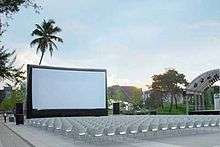Outdoor cinema
An outdoor cinema (also called open-air cinema) consists of a digital or analog movie projector, scaffolded construction or inflatable movie screen, and sound system.

Open-air cinemas first began at around 1916 in Berlin, Germany.[1]
Viewers usually sit on camping chairs or blankets. Some Hollywood world premieres were screened in outdoor cinemas – sometimes with the stars in attendance. Most screenings are free with some raising money for charities.
As projector prices have decreased, guerrilla style outdoor cinemas have become more common. These are run on a very small budget by groups of amateurs. It is common for the events to be organised online, participants then meet in parks, empty parking lots or other public places. Guerrilla outdoor cinemas are very basic, often needing to be completely set up and dismantled in a single night. Sheets, portable screens or existing walls are used as a screen for the projected image. Power is obtained from generators or car batteries.
These kind of cinemas are very popular in Greece during the summer period with at least 90 operating in Athens, as of 2015.In the Sixties, the city used to host more than 600 outdoor cinemas.[2]
Examples

Large and well-known open-air cinemas include the Outdoor Cinema Food Fest in California, Oshkosh’s Fly-In theater,[3] Screen on the Green (Atlanta) or Sunset Cinema[4] in Australia. More and more often prestigious film festivals add outdoor movies to their regular screenings. Some of the most important outdoor movie events were the world premiere of Shark Tale on St. Mark’s Square at Venice Film Festival (2004)[5] and open air at Dubai International Film Festival (2011).[6]
There are also more private open-air cinemas, sometimes as a part of a pool or backyard party. Unusual locations to show a movie outdoors include of skyscraper rooftops, screens floating on a lake with spectators sitting on boats, screenings where guests watch a movie in hot tubs or drive-in cinemas on the top floor of a parking garage. A special type of outdoor cinema is the drive-in theater.
In cold weather climates, public film screenings have been projected onto surfaces of snow, in such countries as Finland and Canada.[7][8][9]
DIY Outdoor Theaters
Throughout the US and Canada there has been an increasing interest in homemade backyard theaters. While drive-in theaters are somewhat a relic of the past cheaper projector technology has allowed families to enjoy movies in the comfort of their own homes.
The material needed to set up such theaters is quite simple. Basic setup involves three items: screens, projectors and wiring. Outdoor projectors are similar to regular projector units although they are often smaller and don't contain internal speaker units. These units are required to be placed on a stand or other stable object to ensure that projector pitch can be calibrated accurately.
Screens are generally constructed out of Tyvek material which allows for maximum durability while not sacrificing screen quality. Wiring involves a basic 120v AC cord that can be attached to outdoor outlets. Additionally, some cords are buried underground to a fixed station to provide a stable reliable projector surface without any protruding wires.
The ideal distance for outdoor projectors is roughly 7-10 feet although some higher-end units can project from much further. The distance between the two points is referred to as the throw distance and requires a simple measurement (D/W = Rt) with D = distance and W = width of screen.[10]
See also
References
- ↑ History of open-air cinema
- ↑ http://www.telegraph.co.uk/travel/destinations/europe/greece/captivating-holidays/outdoor-cinemas-in-athens/
- ↑ General Aviation news, Fly-In Theater returns to Oshkosh
- ↑ Sunset Cinema's 2016/2017 Season
- ↑ Shark Tale world premiere
- ↑ Dubai Film Festival is back for its 8th year
- ↑ Edmonton AM (Feb 16, 2016). "Fort McMurray man builds outdoor theatre out of snow". CBC. Retrieved 21 October 2016.
- ↑ Tytti, Ollila. "The day of the Europe's northernmost indigenous people". gbtimes.com. Retrieved 31 October 2016.
- ↑ Eisner, Ken (11 March 2004). "There's Snow Business Like Show Business In Canada". Georgia Straight. Retrieved 31 October 2016.
- ↑ "How to Calculate Projector Throw Distance". Outdoor Movie HQ. Retrieved 8 November 2016.
External Links
Guide to Outdoor Movie Theaters at Outdoor HQ